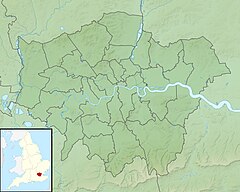| Wimbledon Manor House | |
|---|---|
| Location | Wimbledon Park, London, SW19 |
| Coordinates | 51°25′46.3512″N 0°12′31.8204″W / 51.429542000°N 0.208839000°W |
| Founded | c.1328 |
| Built | c.1500 |
| Built for | The Church of England, Sir Thomas Cecil, Sir Theodore Janssen, The Duchess of Marlborough, Earl Spencer |
| Demolished | C.1725,1785,1900,1949 |
| Rebuilt | 1588, 1720, 1733, 1801 |
| Architect | Colen Campbell, Henry Herbert, Henry Holland |
| Architectural style(s) | Tudor, Elizabethan, Palladian, Regency |
Wimbledon manor house; the residence of the lord of the manor, was an English country house at Wimbledon, Surrey, now part of Greater London. The manor house was over the centuries exploded, burnt and several times demolished. The first known manor house, The Old Rectory was built around 1500 still stands as a private home, despite very nearly falling into a state beyond repair, in the 19th century. The ambitious later Elizabethan prodigy house, Wimbledon Palace, was "a house of the first importance" according to Sir John Summerson, and is now demolished.[1]
The manor house passed through several further iterations, being entirely rebuilt three times. From the 18th Century onwards the manor lands began to reduce in size as various owners sold off parts. What was known as the 'Old Park', an area of around 300 acres stretching westwards from the present Cannizaro House (now a hotel) and public park, was sold off in 1705. Most of the present day Wimbledon Common was also once part of the manor, with grazing rights given to tenants of the lord of the manor.
The Common was saved from enclosure and development in 1871 by a remarkably early act of conservation. 42 acres, previously part of the manor parklands, are now occupied by the All England Lawn Tennis and Croquet Club that has made Wimbledon synonymous with tennis. Further tracts of the Grade II* listed public Wimbledon Park include its present-day golf course and the lake, the latter created along with further improvements to the park by the famous landscaper 'Capability' Brown for Earl Spencer, in 1768.[2]
- ^ Summerson 2012, 13.. 53Wimbledon and the H-plan," Architecture in Britain 1530-1830, 4th ed. p. 36.
- ^ Jane Brown, Lancelot 'Capability' Brown, 1716-1783: The Omnipotent Magician, "Earl Spencer's Wimbledon", pp278f; she notes that the architectural historian Dorothy Stroud located the approximate site of the house on upper Home Park Road, near its intersection with Arthur Road.
